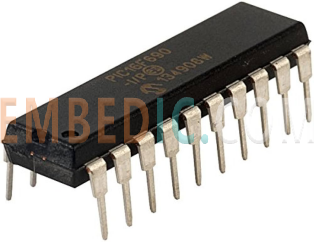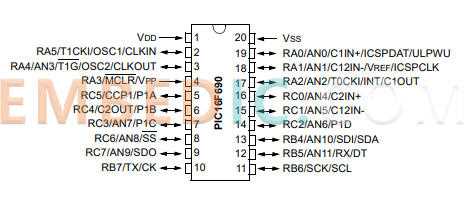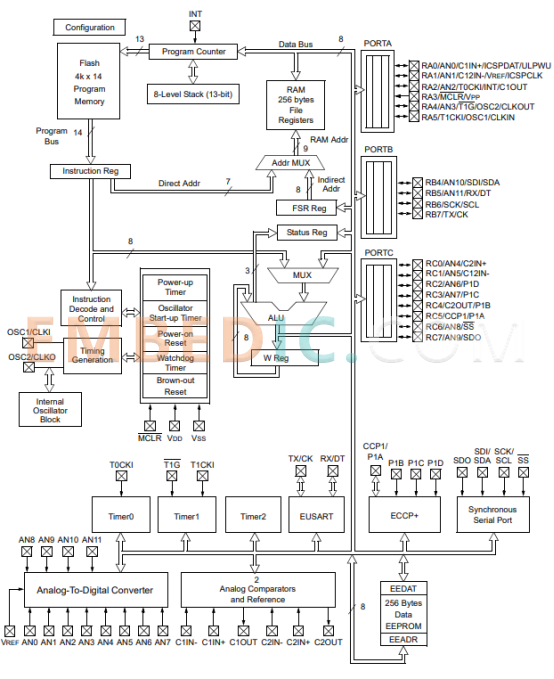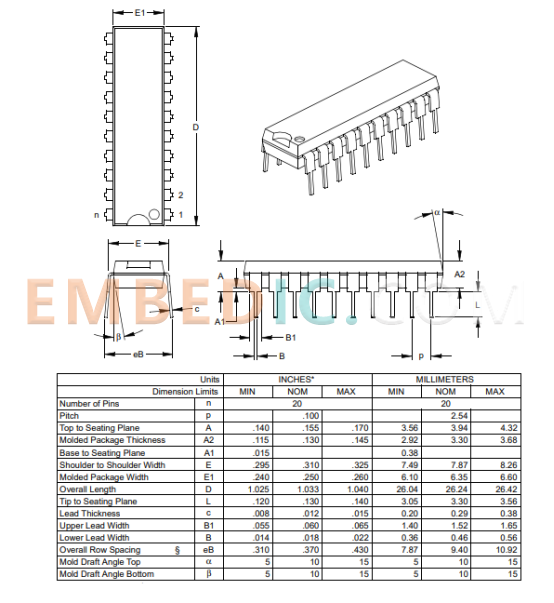Microchip's PIC16F690 stands as a prominent member of the Low Pin-count (20) PIC® Flash microcontroller family, renowned for its compatibility with the established mid-range x14 architecture. This 8-bit microcontroller combines compact design with powerful features, offering a wide operating voltage range, integrated EEPROM Data Memory, and nanoWatt Technology for enhanced power efficiency. Let's delve into the key attributes that make the PIC16F690 a versatile and preferred choice in the realm of embedded systems and electronics.
Microchip's PIC16F690 microcontroller is an 8-bit member of the Low Pin-count (20) PIC® Flash microcontroller family, renowned for its compatibility with the well-established mid-range x14 architecture. This compact yet powerful microcontroller offers standardized features, including a broad operating voltage range of 2.0-5.5 volts, integrated EEPROM Data Memory, and nanoWatt Technology for enhanced power efficiency.

At its core, the PIC16F690 incorporates a high-performance RISC CPU, executing instructions at a commendable speed. The board supports the connection of a crystal oscillator with a frequency of up to 20 MHz, providing a reliable source of clock pulses.
Operating within the standard PIC voltage range of 2 to 5.5 V, the PIC16F690 boasts 7K of program memory and 256 bytes of RAM. Additionally, it features an EEPROM with a capacity of approximately 256 bytes, contributing to versatile data storage capabilities.
Key features include compatibility with external components through I2C, SPI, and USART connections, expanding its utility across a wide array of applications. The Analog-to-Digital Converter (ADC) module is pivotal for converting analog signals to digital values, facilitating seamless sensor interfacing.
The PIC16F690 is available in two distinct packages, namely PDIP (Plastic Dual In-line Package) and QFP (Quad Flat Package), both equipped with a 20-pin interface. This microcontroller's versatility, standardized features, and compatibility make it a preferred choice for applications demanding a balance between performance and compact design.

|
Pin Number |
Pin Name |
Function |
Description |
|
19 |
RA0/AN0/C1IN+/ICSPDAT/ULPWU |
RA0 |
General-purpose I/O. Individually controlled interrupt-on-change. Individually enabled pull-up. AN0: A/D Channel 0 input. C1IN+: Comparator 1 positive input. ICSPDAT: ICSP Data I/O. ULPWU: Ultra Low-Power Wake-up input. |
|
18 |
RA1/AN1/C12IN-/VREF/ICSPCLK |
RA1 |
General-purpose I/O. Individually controlled interrupt-on-change. Individually enabled pull-up. AN1: A/D Channel 1 input. C12IN-: Comparator 1 or 2 negative input. VREF: External Voltage Reference for A/D. ICSPCLK: ICSP™ clock. |
|
17 |
RA2/AN2/T0CKI/INT/C1OUT |
RA2 |
General-purpose I/O. Individually controlled interrupt-on-change. Individually enabled pull-up. AN2: A/D Channel 2 input. T0CKI: Timer0 clock input. INT: External Interrupt. C1OUT: Comparator 1 output. |
|
4 |
RA3/MCLR/VPP |
RA3 |
General-purpose input. Individually controlled interrupt-on-change. MCLR: Master Clear with internal pull-up. VPP: Programming voltage. |
|
3 |
RA4/AN3/T1G/OSC2/CLKOUT |
RA4 |
General-purpose I/O. Individually controlled interrupt-on-change. Individually enabled pull-up. AN3: A/D Channel 3 input. T1G: Timer1 gate input. OSC2: Crystal/Resonator. CLKOUT: FOSC/4 output. |
|
2 |
RA5/T1CKI/OSC1/CLKIN |
RA5 |
General-purpose I/O. Individually controlled interrupt-on-change. Individually enabled pull-up. T1CKI: Timer1 clock input. OSC1: Crystal/Resonator. CLKIN: External clock input/RC oscillator connection. |
|
13 |
RB4/AN10/SDI/SDA |
RB4 |
General-purpose I/O. Individually controlled interrupt-on-change. Individually enabled pull-up. AN10: A/D Channel 10 input. SDI: SPI data input. SDA: I²C data input/output. |
|
12 |
RB5/AN11/RX/DT |
RB5 |
General-purpose I/O. Individually controlled interrupt-on-change. Individually enabled pull-up. AN11: A/D Channel 11 input. RX: EUSART asynchronous input. DT: EUSART synchronous data. |
|
11 |
RB6/SCK/SCL |
RB6 |
General-purpose I/O. Individually controlled interrupt-on-change. Individually enabled pull-up. SCK: SPI™ clock. SCL: I²C™ clock. |
|
10 |
RB7/TX/CK |
RB7 |
General-purpose I/O. Individually controlled interrupt-on-change. Individually enabled pull-up. TX: EUSART asynchronous output. CK: EUSART synchronous clock. |
|
16 |
RC0/AN4/C2IN+ |
RC0 |
General-purpose I/O. AN4: A/D Channel 4 input. C2IN+: Comparator 2 positive input. |
|
15 |
RC1/AN5/C12IN- |
RC1 |
General-purpose I/O. AN5: A/D Channel 5 input. C12IN-: Comparator 1 or 2 negative input. |
|
14 |
RC2/AN6/P1D |
RC2 |
General-purpose I/O. AN6: A/D Channel 6 input. P1D: PWM output. |
|
7 |
RC3/AN7/P1C |
RC3 |
General-purpose I/O. AN7: A/D Channel 7 input. P1C: PWM output. |
|
6 |
RC4/C2OUT/P1B |
RC4 |
General-purpose I/O. C2OUT: Comparator 2 output. P1B: PWM output. |
|
5 |
RC5/CCP1/P1A |
RC5 |
General-purpose I/O. CCP1: Capture/Compare input. P1A: PWM output. |
|
8 |
RC6/AN8/SS |
RC6 |
General-purpose I/O. AN8: A/D Channel 8 input. SS: Slave Select input. |
|
9 |
RC7/AN9/SDO |
RC7 |
General-purpose I/O. AN9: A/D Channel 9 input. SDO: SPI data output. |
|
20 |
VSS |
VSS |
Ground reference. |
|
1 |
VDD |
VDD |
Positive supply. |
PIC16F690 is a high-performance RISC microcontroller with a 35-instruction set, operating at up to 20 MHz. It features a deep hardware stack, precise internal oscillator, versatile addressing modes, and power-saving capabilities. With peripherals like enhanced USART, analog comparator, A/D converter, and timers, it's suitable for various embedded applications. The microcontroller's low-power features, efficient memory, and support for serial communication make it a flexible and energy-efficient choice for embedded systems.
Here is a summary and overview of its key characteristics:
CPU Architecture:
Addressing Modes:
Precision Internal Oscillator:
Power Management:
Memory:
Communication Features:
Low-Power Characteristics:
Peripheral Features:
Serial Communication:
Programming and Debugging:
|
Parameter |
Specification |
|
Program Memory Size (KB) |
7 |
|
RAM |
256 |
|
Data EEPROM (bytes) |
256 |
|
Pin Count |
20 |
|
Operation Voltage Max. (V) |
5.5 |
|
Operation Voltage Min. (V) |
2 |
|
ADC Resolution Max |
10 |
|
ADC Channels |
12 |
|
Zero Cross Detect |
False |
|
Number of Comparators |
2 |
|
SPI |
1 |
|
I2C |
1 (I2C) |
|
Standalone PWM |
0 |
|
Low Power |
No |
|
Numerically Controlled Oscillator (NCO) |
0 |
|
Data Signal Modulator (DSM) |
0 |
The PIC16F690 microcontroller serves a myriad of applications, catering to both educational and practical needs. Its versatile capabilities make it an ideal choice for various projects, including:
Student Projects for Interfacing Sensor and Motor Controlling:
PIC16F690 facilitates student projects that involve interfacing sensors for data acquisition and motor control. It provides a hands-on learning experience in sensor integration and real-time motor control applications.
Central Heating Projects:
In central heating systems, the PIC16F690 can be employed for temperature sensing, control algorithms, and interfacing with heating elements. Its low power modes are advantageous for efficient energy management.
Serial Communication:
The microcontroller's support for serial communication protocols, such as UART, makes it valuable for projects involving data exchange between devices. It is commonly used in applications requiring reliable and efficient serial communication.
Production of Temperature Data Logger:
PIC16F690 is well-suited for creating temperature data loggers. Its built-in ADC can be utilized to measure temperature, and the data can be logged for analysis or monitoring purposes.
Main Part of the Embedded System:
As a fundamental component of embedded systems, the PIC16F690 plays a central role in various applications, providing processing power, control, and connectivity in compact and resource-efficient designs.
Used in Industrial Automation:
PIC16F690 finds application in industrial automation, where it can control processes, monitor sensors, and interface with other devices. Its robust features make it suitable for integration into automated manufacturing systems.
Used in Security Systems:
Security systems benefit from the PIC16F690's capabilities in interfacing with sensors, processing input signals, and controlling security features. It is commonly employed in access control, surveillance, and alarm systems.
Gas Sensor Projects:
PIC16F690 is utilized in projects involving gas sensors for detecting and monitoring gas concentrations. It processes sensor data and can trigger appropriate responses or alerts based on predefined thresholds.
Starter Kits:
PIC16F690 is frequently included in starter kits, serving as an introductory platform for enthusiasts and beginners to explore microcontroller programming. Starter kits often feature sample projects to help users understand its capabilities.
These diverse applications highlight the adaptability of the PIC16F690 across educational, industrial, and hobbyist projects, making it a versatile and widely-used microcontroller in the realm of embedded systems and electronic applications.

Here are alternative microcontrollers to the PIC16F690
|
Part Number |
Features |
Advantages |
|
PIC16F690-I/SO |
- 8-BIT, FLASH, 20 MHz RISC Microcontroller - 7.50 MM, PLASTIC, SOIC-20 - Integrated EEPROM Data Memory - Analog peripherals: Up to 12 channels of 10-bit A/D, analog comparators, ECCP+ module |
- Compact 20-pin SOIC package for space-efficient designs. - Wide operating voltage range (2.0-5.5V) for versatile applications. - nanoWatt Technology for enhanced power efficiency. - Supports I2C, SPI, and USART connections for compatibility with external components. |
|
PIC16F690T-I/SO |
- 8-BIT, FLASH, 20 MHz RISC Microcontroller - 7.50 MM, PLASTIC, SOIC-20 - Integrated EEPROM Data Memory - Analog peripherals: Up to 12 channels of 10-bit A/D, analog comparators, ECCP+ module |
- Similar features to PIC16F690-I/SO with compatibility in a different package. - Flexibility in board design and integration with the SOIC package. - Broad operating voltage range and nanoWatt Technology for power optimization. - Versatile in applications, suitable for various embedded systems and electronics projects. |

Download PIC16F690 datasheet PDF here>>
Microchip Technology Incorporated is a leading American integrated circuit provider, specializing in the research and development of microcontrollers, mixed-signal, analog, and Flash-IP integrated circuits. The company's products find wide applications in automotive, industrial automation, computing, consumer electronics, and various other fields. With a diverse product portfolio that includes PIC microcontrollers, Atmel AVR and SAM microcontrollers, as well as a range of analog and mixed-signal solutions, Microchip Technology is renowned for its innovative technology and versatility. It stands as a significant participant in the electronics industry.
Building on its outstanding technological capabilities and comprehensive product offerings, Microchip Technology Incorporated has emerged as a key driver in the electronics sector. The company focuses on meeting the diverse needs of industries such as automotive, industrial automation, and consumer electronics by providing advanced microcontrollers and mixed-signal solutions, offering innovative design choices to its customers. Widely applied in smart systems, embedded control, sensor technologies, and other critical domains, Microchip's products contribute to technological innovation across global industries. Through continuous advancements at the forefront of technology and close collaboration with customers, Microchip Technology maintains a competitive edge in the electronics market, delivering reliable solutions for connecting the world.
In conclusion, the PIC16F690 microcontroller from Microchip Technology serves as a cornerstone in diverse applications, bridging the gap between performance and space efficiency. Its low pin-count design, wide operating voltage range, and integrated features such as EEPROM Data Memory and nanoWatt Technology contribute to its adaptability across various projects. Whether facilitating student projects, contributing to central heating systems, enabling serial communication, or serving as a fundamental part of embedded systems, the PIC16F690 remains a reliable and versatile solution.
As technology continues to advance, Microchip Technology Incorporated's commitment to innovation ensures that the PIC16F690 remains at the forefront of microcontroller solutions, connecting the world through its reliable and efficient performance.
Manufacturer: Texas Instruments
IC DGTL MEDIA PROCESSR 1031FCBGA
Product Categories: DSP
Lifecycle:
RoHS:
Manufacturer: Analog Devices
IC DSP 32/40BIT 400MHZ 324CSBGA
Product Categories: DSP
Lifecycle:
RoHS:
Manufacturer: Texas Instruments
IC DSP FIX/FLOAT POINT 176HLQFP
Product Categories: DSP
Lifecycle:
RoHS:
Manufacturer: Texas Instruments
IC DGTL MEDIA PROCESSR 684FCBGA
Product Categories: DSP
Lifecycle:
RoHS:
Looking forward to your comment
Comment